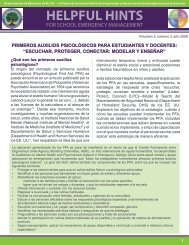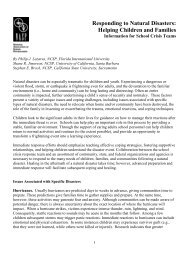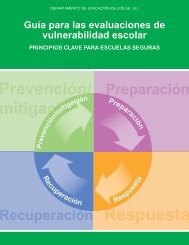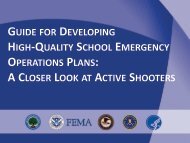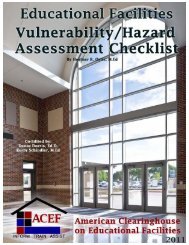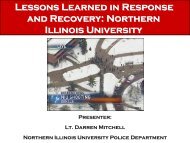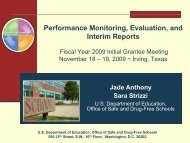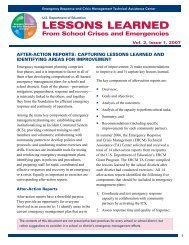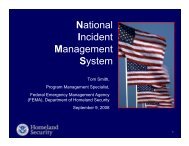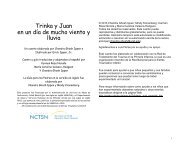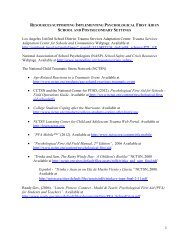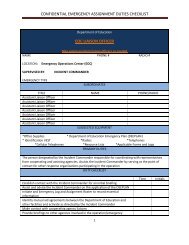Safety Assessment Program Evaluator Student Manual
Safety Assessment Program Evaluator Student Manual
Safety Assessment Program Evaluator Student Manual
You also want an ePaper? Increase the reach of your titles
YUMPU automatically turns print PDFs into web optimized ePapers that Google loves.
CA Emergency Mgmt. Agency <strong>Safety</strong> <strong>Assessment</strong> <strong>Program</strong> <strong>Evaluator</strong> <strong>Manual</strong> April 2011Exit doorsVerify operation of the doors. Do the doors operate smoothly and easily? Do theyopen fully, or are there restrictions of any kind?Identify falling hazards. This includes exterior as well as interior. Are there parapets orornamentation on the exterior that could block the exit if they fell? Is there masonry orbrick veneer around the door opening, what is its condition, and could it block the door ifthe connections failed? Within the building, has the ceiling fallen or is it threatening tofall? Are there special light fixtures over the door or in the area that could be a hazard, orblock the door if they fell? What is their current condition?Verify condition of pathway to and from the exit doors. Is the area around theexterior of the door clear and free of debris? Is the interior pathway to the remainder ofthe building free of debris?CorridorsIdentify falling hazards. What is the condition of the ceiling? What is the material?Are there any light fixtures or other ornamentation that could block the exit if they fell?What is the condition of their connections?Verify operation of the doors into other rooms. Are the doors fully operational? Is thearea around both sides of the door clear? Are there potential hazards that could block thedoor?Note the level of illumination. Most likely, the electricity will be off in the building.Therefore, one should see if there is natural light to illuminate the corridor, or if artificiallight is required.StairwaysDetermine if stairs are free of debris or obstacles.Determine structural condition of the stairs. This investigation should include treads,stringers, handrails and the connections of the stringers to the landing and the floor.Since no destructive testing can be done by SAP evaluators, this part of the investigationmay have to be based largely on opinion and judgment.Determine structural conditions of the stair landings. Be extremely careful about this,since stairways may respond to earthquakes differently from the building overall, andthere might not be a landing where it should be! One evaluator discovered to his shockthat what he was about to walk on was only carpet, held by the tack strips at the sides; thelanding itself had collapsed beneath him!The evaluation findings should be noted on the evaluation forms in the Remarks or Comments section, oron a separate piece of paper attached to the form. Since access to UNSAFE buildings must be only withthe written permission of the building official, the jurisdiction will have a clear path to the informationgathered by the detailed evaluation team on that particular building. When the owner requests permissionto retrieve possessions, the building official does not need to conduct a new evaluation in order to respondto the request.Be certain that the information conveyed on the forms or during debriefing is factual. The jurisdictionwill use this information to determine if any additional hazard mitigation is required before access isallowed to retrieve possessions.76



